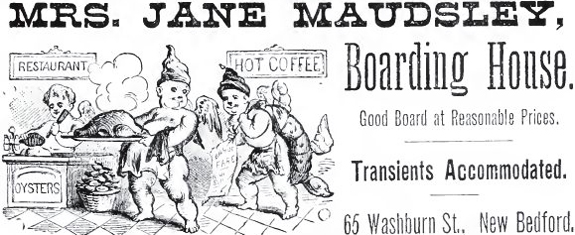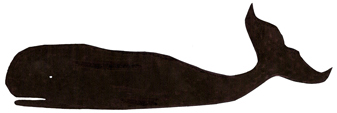Local New Bedford, Ma. History
1890 - 1899 In Chronological Order
|
 |
|
| |
1890
Electric Trolley Cars replaced horsecars for the New Bedford and Fairhaven Street Railway. |
| |
1890
There were 41 people in the city who were considered to be insane and poor that were taken care of at city expense.
Thirty-six were kept at the Taunton Lunatic Hospital and the others distributed at Westborough Insane Hospital, Worcester Insane Hospital, Worcester Lunatic Hospital and Massachusetts School for Feeble-minded.
The average daily attendance at the alms house was 75, 9 in the workhouse and 12 in the truant school.
|
| |
1890's
The Common Park was the first public common in New Bedford.
It was the town green. The land was purchased and improved by the city.
During this time, the city bought most of the land that was to become the city's parks. Brooklawn Park was Daniel Rickettson's estate. Rickettson is the source of much of the earliest history of the area.
He published an influential book on local history in 1858. |
| |
1890
Population was 40,733. The post offices were New Bedford (main post office) and Clifford also those of the villages Rockdale, Cannonville, Jesseville, and Kennersonville.
|
| |
1891
Charles S. Ashley elected Mayor. He served as mayor for thirty-two years between 1891 and 1936
St. Mary's school had it's first graduation with one boy and 4 girls graduating. Jeremiah Coholan, and Mary Perry, Nellie Rau, Annie Rau and Jennie Murphy.
|
| |
1892
The Lizzie Borden Trial began at the Superior Court House on Court Street and County Street.
The trial was infamous, and much talked about in its day and for many years later.
It is widely thought that she did kill her parents, but she got away with it.
Her former home is today The Lizzie Borden Bed and Breakfast Museum in Fall River.
It is at 92 2nd Street,
Fall River, MA.
The prosecutor in the trial lived in a home on the corner of Union and Cottage streets, in New Bedford. |
| |
1892
The Coggeshall Street bridge was finished and established the dividing line between the upper and lower harbor. |
| |
| 1893 The life of Thomas Crapo is published - read the story of him and his wife |
| |
1893
Liberty Hall on the corner of Purchase street and William Street is demolished, and the Merchants National Bank erected a building for the new location there. |
| |
1894
A trolley system to Fall River is established.
1894
The Grand Banks fishing Schooner "Ernestina" now docked in New Bedford was built in Essex.
It is the only surviving packet schooner that had brought immigrants to New Bedford from Cape Verde.
In its life, it also served as an arctic exploration vessel. |
| |
1896
The new St. Luke's hospital opened at 101 Page Street.
It had 4 buildings.
Architect Charles Makepeace had designed the Victoria Textile Mill, and it was built in is year. It was designed by renowned architect Charles Makepeace. During its heyday, the mill had 177,608 spindles and 4,610 looms. It closed due to the economic problems that plagued other mills in the city.
By the 21st century, it was listed to be listed on the National Register of Historic Places.
In 2011, the 10 Manomet St. location had been rehabilitated as 100 individual one and two bedroom apartments and renamed the Victoria Riverside Townhouse Lofts. |
| |
1897 Feb. 27
There was a massive boiler explosion at the Acushnet Mills and at least 2 people killed outright and more than a dozen workers injured.
A building almost a quarter mile distant was nearly demolished by flying metal debris.
A large piece of a boiler landed in a police station that was 700 feet from its launch site. Two boilers, as well as the harness shop and cloth room, were wrecked by the explosion. The boilers were horizontal tubular boilers 16 feet long and 72 inches in diameter and normally run at 95 pounds of pressure.
See pictures: Boiler location - Picker Room - Police Station |
| |
1897
Lupo's Restaurant, 363 Acushnet Avenue was built on the corner of Acushnet Avenue, and William Street.
It was a notoriously popular spot for food, drink and live music for many years.
In the early 1990's Roger Chartier ran the place and it had a real heyday with live music, bands and solo acts, small theatrical performances, karaoke, etc. in three separate areas of the building.
It closed after his departure and was never opened again.
Although it was of historical value and a viable property, subsequent owners failed to make anything of it.
The Mount Vernon Group razed the building in 2004 with a plan to build five residential units above retail shops on the site. As of 2013 it is still an empty lot. |
| |
In 1897 New Bedford, the electric company provided power to 200 arc street-lamps and over 20,000 incandescent lamps in homes and buildings. Gas lighting was being replaced by electric light.
Factories used electric motors and the demand was enormous.
The electric company supplied about 300 horsepower for that purpose. |
| |
1897
Elizabeth Carter Brooks was the daughter of a freed slave.
She founded the New Bedford Home For The Aged in this year.
Later in the 1960's a grammar school on 212 Nemasket Street was named after her.
|
| |
1898
New Bedford Textile School is established and eventually the school would metamorphose into what today is UMASS Dartmouth |
| |
1898
Star Store (aka New Bedford Dry Goods Co.) opened on Union Street It had the country's first escalator |
| |
1898
The Second New Bedford orphan's Home opened at a larger facility on Taber Street
replacing the first one near Rodney French Blvd and Cove Street. At the time Rodney French Blvd was called French Avenue. The same site was the lot where the Washington Club was built, and the location from the liquor license issued in 1898 is 2 Harmony Street. Therefore it was on the corner of Harmony and Social streets. That block is adjoining the intersection of Cove and Rodney French on the southwest side. See the Picture and map of the Washington Club as it was in 1921. |
| |
1898
Butler Flats light house is built in 1898 and first lit in that year.
It is round, 53 feet tall, and it's made of cast iron, concrete and brick.
It was built to replace the light at Clark's point (Fort Rodman / Fort Taber ) |
| |
Late 1890's
Pine Grove Cemetery on 1100 Ashley Blvd.
has a special World War 1 Veterans Plot with the graves of some World War 1 Veterans in it.
It is also the site of the greenhouses, to grow plants and flowers for the cemetery grounds, veterans plots and flower beds established by perpetual care flower fund deposits.
There is a mausoleum for the body of Bishop Charles H Grace (Sweet Daddy Grace).
Former Mayor of New Bedford, Leo. H. Carney, is buried there.
It is about 50 acres in size.
|
| |
1899
New Bedford Board of health determines that swimming in the Acushnet river is dangerous to the health.
The construction began on a newer New Bedford - Fairhaven Bridge that would have a swivel in the middle and the spot where it connected to Fairhaven was moved a bit north. |
| |
1899
Ahavath Achim synagogue's construction is finished on Howland Street. |

